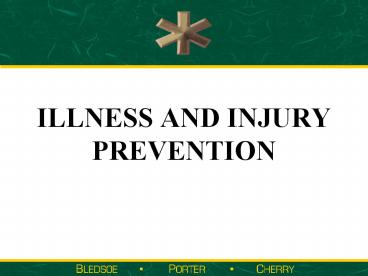ILLNESS AND INJURY PREVENTION - PowerPoint PPT Presentation
1 / 25
Title:
ILLNESS AND INJURY PREVENTION
Description:
Injuries result from interaction with potential hazards in ... equipment, such as protective gloves and eyewear, is one of a provider's basic lines of defense. ... – PowerPoint PPT presentation
Number of Views:441
Avg rating:3.0/5.0
Title: ILLNESS AND INJURY PREVENTION
1
ILLNESS AND INJURY PREVENTION
2
Topics
- Impact of Unintentional Injuries
- Community Hazards and Crime Areas
- Community Resources
- Illness and Injury Prevention
3
Introduction
- Injury is one of our nations most important
health problems. - Injuries result from interaction with
potential hazards in the environment, which
means that they may be predictable and
preventable.
4
Facts About Injury
- Injury is the 3rd leading cause of death.
- Unintentional injuries result in 70,000 deaths
annually. - The estimated lifetime cost of injuries will
exceed 144 billion. - For every death caused by injury, there are an
estimated 19 hospitalizations.
5
Epidemiology
- The study of the factors that influence the
frequency, distribution, and cause of injury,
disease, and other health- related events in a
population.
6
Injury (1 of 2)
- Intentional or unintentional damage to a
person resulting from acute exposure to
thermal, mechanical, electrical, or chemical
energy or from the absence of such essentials
as heat and oxygen.
7
Injury (2 of 2)
- Unintentional injury is an accident.
- Intentional injury is purposefully inflicted
on a person, e.g., homicide.
8
As medical professionals, EMS providers should
assess every scene and situation for injury risk.
9
Prevention (1 of 2)
- EMS providers can focus on primary prevention,
or keeping an injury from ever occurring. - Such prevention can occur as teachable moments
that occur shortly after an injury when the
patient and observers remain acutely aware of
what has happened and may be receptive to
learning how to prevent a similar incident in
the future.
10
Prevention (2 of 2)
- Secondary prevention occursduring medical care.
- Tertiary prevention occurs during rehabilitation
activities.
11
Prevention within EMS
- Few experience the aftermath of trauma more
directly than EMS providers. - EMTs and paramedics are widely distributed in
the population and are often role models for the
community. - Paramedics have become prime candidates to be
advocates of injury prevention.
12
- The more than 600,000 EMS providers
- in the United States comprise a great arsenal in
the war to prevent injury - and disease.
13
Organizational commitment is vital to the
development of any prevention activities.
14
Primary responsibilities include
- Protection of EMS Providers
- Education of EMS Providers
- Data Collection
- Financial Support
- Empowerment of EMS Providers
15
When appropriate, specific EMS education and
training in specialized safety procedures should
be available to you.
16
Funding for illness/injury campaigns may be
contributed by corporations and advertising
agencies, as well as non-profit agencies.
17
Data should be collected and incorporated into
patient documentation.
18
EMS Provider Commitment
- Body Substance Isolation (BSI) Precautions.
- Physical Fitness.
- Stress Management.
- Seeking Professional Care.
- Driving Safety.
- Scene Safety.
19
BSI equipment, such as protective gloves and
eyewear, is one of a providers basic lines of
defense.
20
Keep your safety equipment in good condition and
readily available in your emergency vehicle.
21
Prevention in the Community
- EMS has a responsibility not only to prevent
injury and illness among workers, but also to
promote prevention among the members - of the public.
- EMS providers can be an appropriate and
effective means of prevention in several
situations.
22
Areas in Need of Prevention Activities (1 of 2)
- Low birth weight in newborns.
- Unrestrained children in motor vehicles.
- Bicycle-related injuries.
- Household fire and burn injuries.
- Unintentional firearms injuries.
23
Areas in Need of Prevention Activities (2 of 2)
- Alcohol-related motor vehicle collisions.
- Fall injuries in the elderly.
- Workplace injuries.
- Sports and recreation injuries.
- Misuse or mishandling of medication.
- Early discharge of patients
24
Implementation of Prevention Strategies
- Preserve the safety of the response team.
- Recognize scene hazards.
- Document findings.
- Engage in on-scene education.
- Know your community resources.
- Conduct a community needs assessment.
25
Summary
- Impact of Unintentional Injuries
- Community Hazards and Crime Areas
- Community Resources
- Illness and Injury Prevention
26
- http//www.safetylit.org./
- http//www.nhtsa.dot.gov/people/outreach/KidsPage/
ems/ - http//www.nhtsa.dot.gov/people/injury/index.html
- http//www.nhtsa.dot.gov/real/index.html































